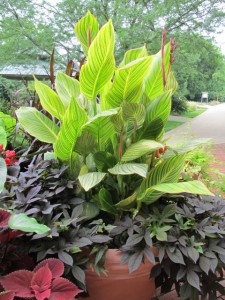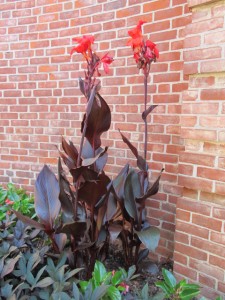Depending on where you garden, Canna lily (Canna spp.) is a tropical-looking, herbaceous annual or perennial. Its colorful foliage and long blooming time leaves a huge visual impact. Canna is not reliably winter hardy in the Southern Appalachian region (USDA hardiness zones 6 and 7). Canna relishes moist soils. Container grown plants thrive submerged in a water garden.
Leaves wrap spirally around the main stem(s). Most cultivars have emerald-green foliage, either a waxy (glaucous) or dull (matted) leaf surface. Some exhibit colorful andvariegated foliage. New canna leaves unfurl at night.
Canna flowers from midsummer up to first frost. Cultivar heights range from 5 to 15 feet (and more), depending on the cultivar and its care. Removal of spent flowers stimulates formation of new floral heads. Flower choices range from oft-white, yellow, orange, red, and a mosaic of many colors. Canna flowers are visited by bees, hummingbirds, and butterflies.
Three favorites in the colorful foliage category are ‘Australia’ (purple leaf, red flower); ‘Bengal Tiger’ aka ‘Pretoria’ (yellow/green striped leaf, orange flower); ‘Tropicana’ aka ‘Phaison’ (green, red, purple, gold striped leaf, salmon orange flower).
A serious problem of cannas is virus diseases, which cause leaves to distort or mar the colorful foliage. Leaf roller insects may also build up and become a serious pest in some gardens.
In late fall canna rhizomes are lifted from garden beds and stored in dry peat moss above freezing over winter.
More about “Winter Care of Tropicals” in a late October blog.



 Posted in
Posted in 
